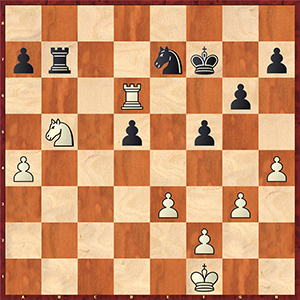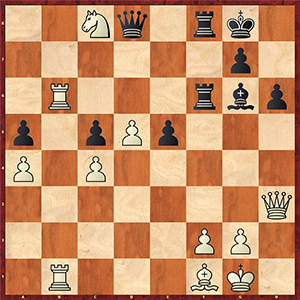17 March 2016
Sergey in Tiger’s Skin
Round four of the candidates tournament in the review of Eteri Kublashvili.
In round four of the paramount round robin event of the year, Sergey Karjakin, having never earlier defeated Anand in a classical game, has finally disturbed this unhappy pattern and gained the upper hand over the Madras Tiger. Prior to that moment Vishy has defeated Sergey on two occasions, and both times with the black pieces at that. It is also worth noting that Anand has never before lost a single game in the Candidate Tournaments.
Sergey Karjakin shared his impressions of this milestone victory of his with your correspondent:
“I succeeded in taking Vishy by surprise in the opening, and that turned out to be a very effective surprise given that it is not every time that you manage to squeeze something out of your opening ideas. I think I obtained a very promising position, and 9.h4 is the fruit of my home preparation. In general, it is difficult to cover every move in your analysis because the game is not of a forced nature. “
Karjakin – Anand

In response to 9…b6 I believe 10. a3 to be a normal move.
10…f5
Here I perhaps played somewhat indecisively by opting for 11. Bb5. It would have made more sense to play 11. Nxd5 immediately in order to meet 11…exd5 with 12. d4. I would evaluate this situation as slightly better for White. On the one hand you have no grounds to count for more, on the other hand it feels rather uncomfortable playing this position for Black.
In the game after 11…Bb7 12. Nxd5 Black could capture on d5 with the queen, which might be a stronger continuation. In response to 13. Bc4 the black queen would retreat to d7 or d6 to meet 14. Ng5 with 14…Nd8; instead of 14. Ng5 White would perhaps be better off castling.
Following 12…exd4 13. d4 I stand better.

13…Rc8 14. dxc5 bxc5 15. 0-0 Bf6 16. Rfd1 Ne7 17. Bxf6 Rxf6 18. g3

We reached the next critical moment when my opponent chose to play 18...Ba6 – a too obvious attempt to finish the game with a draw. After that the evaluation oscillates between better and much better for me. Maybe Black’s super-precise moves would have kept his position together, but I play a risk-free game here anyway. Therefore I consider 18...Ba6 not to be the best option. Apparently, it was necessary to tie further game plans with the d4-advance; perhaps a preventive move 18 ... Kh8 was worth playing first so as to move the d-pawn forward when an opportune occasion presents itself. I think it would have been a lot more reasonable approach.
19. Bxa6 Rxa6 20. Qc3 Rb6 21. Rac1
At this moment my opponent committed a mistake by playing 21…Qd6. After 22. Ne5 I already enjoy a substantial advantage.
In principle, my play in the ending was on a pretty good level; even if Black could have found better moves to defend himself, I think my edge is already way too substantial.
Towards the end of the game Vishy overlooked a beautiful idea when after the end of the time control I played 41. Rd6.

41…Rb6 42. Rd7 a6 43. Nc3. Black is incapable of defending against both 44. Rxe7 or 44. Nxd5, therefore he resigned. The game finished in a study-like fashion.
As the tournament tradition has it, the other three encounters have ended in draws.
Hikaru Nakamura and Anish Giri finished their theoretical duel ahead of all other players. Giri, playing the Black pieces, proved well prepared in a sharp line of the Slav Defence.
Nakamura – Giri

According to Nakamura it was absolutely vital for Black not to go for 24...Kg7 here – a move being perfectly appropriate from a human point of view. The king’s retreat would have been followed with 25. fxg6 fxg6 26. Rf7+ Kxh6 27. Raf1, threatening 28.Na4. The American noted that the computer recommended 28 ... Be3 29. Nd1 Bc8 30. R1f3, etc. Black needed to recall 24...c5!, which Anish duly obliged. After that the game ended in a draw rather quickly.
Peter Svidler drew with Levon Aronian and shared his impressions of the game:
“Both of us had it all written down in our books up to 15...Qf8+. I know the computer evaluation of the position following the exchanges – neither one is better. Maybe it was worth paying closer attention to, because some tricky questions could still be posed in this endgame. Black is most likely keeping his position together, but the way I acted asked not enough questions of my opponent. I could have raised more complex issues in front of my opponent. The way it happened Black was move by move in time to maintain his defense, and it seems to me that even when I ended up with "three versus two" pawn preponderance on the queenside, you really can never win this position due to poor pawn structure, insufficiently active king, plus Levon was defending quite well. This turned out to be a rather logical game.”
For the duration of almost six hours Fabiano Caruana was attempting to upset the birthday boy Veselin Topalov, but after passing the time control the American suddenly pardoned his rival.
Caruana – Topalov

During the press conference both players broke into uniform laughter when reaching this position. In the game Caruana for some incomprehensible reason committed a ridiculous mistake 41. R1b5? (41.Rxf6 wins - 41...Qxf6 42.Rb2 - the thing is that 42 ... Bf5 runs into 43.Qxf5! Qxf5 44.Ne7+), whereas after 41...Rxf2 42. Rxg6 Rxf1+ 43. Kh2 Qxc8 Topalov managed to consolidate and stand his ground.
After four rounds Sergey Karjakin is a sole leader. Trailing half a point behind him is Levon Aronian.
In round five we are in for the following encounters: Giri – Svidler, Anand – Nakamura, Topalov – Karjakin and Aronian – Caruana.






















